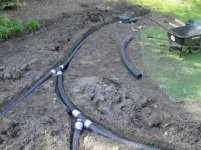jrdepew
Silver Member
All,
I have a french drain on my property which was done by the previous owner. It seems to be working fine, although I don't like where the water is being put currently. I plan to re-do it X years down the road when I get around to it or if it stops working correctly. Anyway, the previous owners lined the top of the drain with large field stone, some pieces are dinner plate sized and stick up out of the soil (lots of clay here). I pulled all the big rocks out as they kept getting whacked by the lawn mower blades and didn't look that great. Where I pulled the large stones out I made sure to remove any sod, then I put down some large drainage rock to about 4-5" from the surface. Following that I put down a layer of pea gravel. The drain is still working properly, but I am wondering if I can put some top soil over the pea gravel and seed it. Most of the french drain is current covered with top soil and grass, except for the sections with the large rocks.
Would this be an okay situation to put topsoil and grass over the top of the french drain?
Let me know if I left anything out.
Thanks,
Joe
I have a french drain on my property which was done by the previous owner. It seems to be working fine, although I don't like where the water is being put currently. I plan to re-do it X years down the road when I get around to it or if it stops working correctly. Anyway, the previous owners lined the top of the drain with large field stone, some pieces are dinner plate sized and stick up out of the soil (lots of clay here). I pulled all the big rocks out as they kept getting whacked by the lawn mower blades and didn't look that great. Where I pulled the large stones out I made sure to remove any sod, then I put down some large drainage rock to about 4-5" from the surface. Following that I put down a layer of pea gravel. The drain is still working properly, but I am wondering if I can put some top soil over the pea gravel and seed it. Most of the french drain is current covered with top soil and grass, except for the sections with the large rocks.
Would this be an okay situation to put topsoil and grass over the top of the french drain?
Let me know if I left anything out.
Thanks,
Joe

